Comprehensive Report: Grief, Loss, and the Impact of Suicide
VerifiedAdded on 2023/06/18
|7
|1945
|81
Report
AI Summary
This report delves into the intricate relationship between grief, loss, and suicide, emphasizing the emotional and psychological challenges individuals face when coping with such profound experiences. It explores various factors that contribute to grief and loss, including relationship breakups, job loss, and the suicide of a loved one, highlighting the particularly complex nature of suicide-related grief. The report employs the Kubler-Ross Grief Cycle, outlining stages like denial, anger, bargaining, depression, and acceptance, to illustrate the emotional journey of those affected by loss. Additionally, Bowlby’s Attachment Theory is used to explain how broken emotional attachments can lead to distress and emotional disturbance, discussing phases such as numbing, yearning, disorganization, and reorganization. The report concludes by underscoring the prolonged and complicated nature of grief, emphasizing the need for support and understanding in navigating the challenging path to acceptance and recovery. This document is available on Desklib, where students can find a wealth of study resources, including past papers and solved assignments.
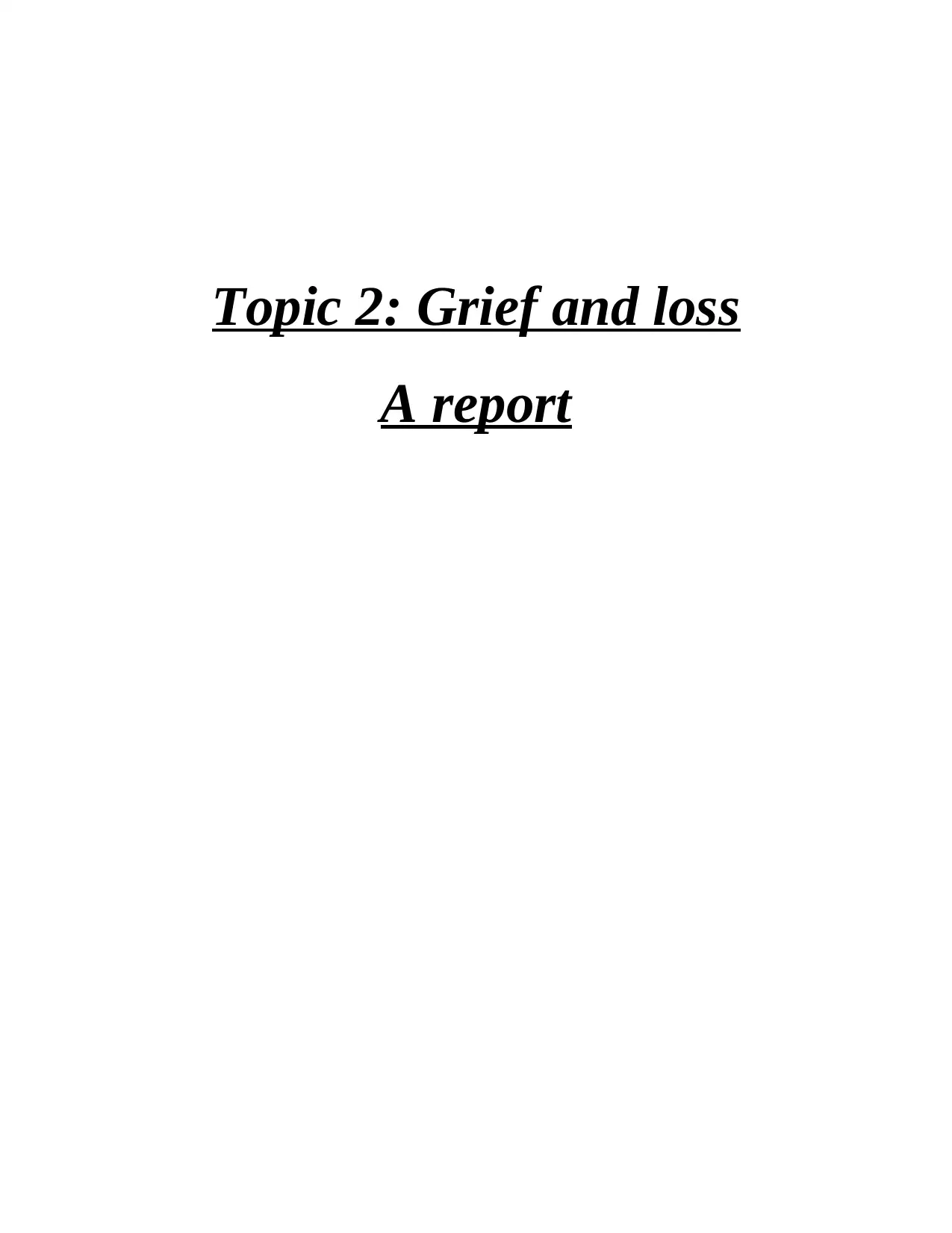
Topic 2: Grief and loss
A report
A report
Paraphrase This Document
Need a fresh take? Get an instant paraphrase of this document with our AI Paraphraser
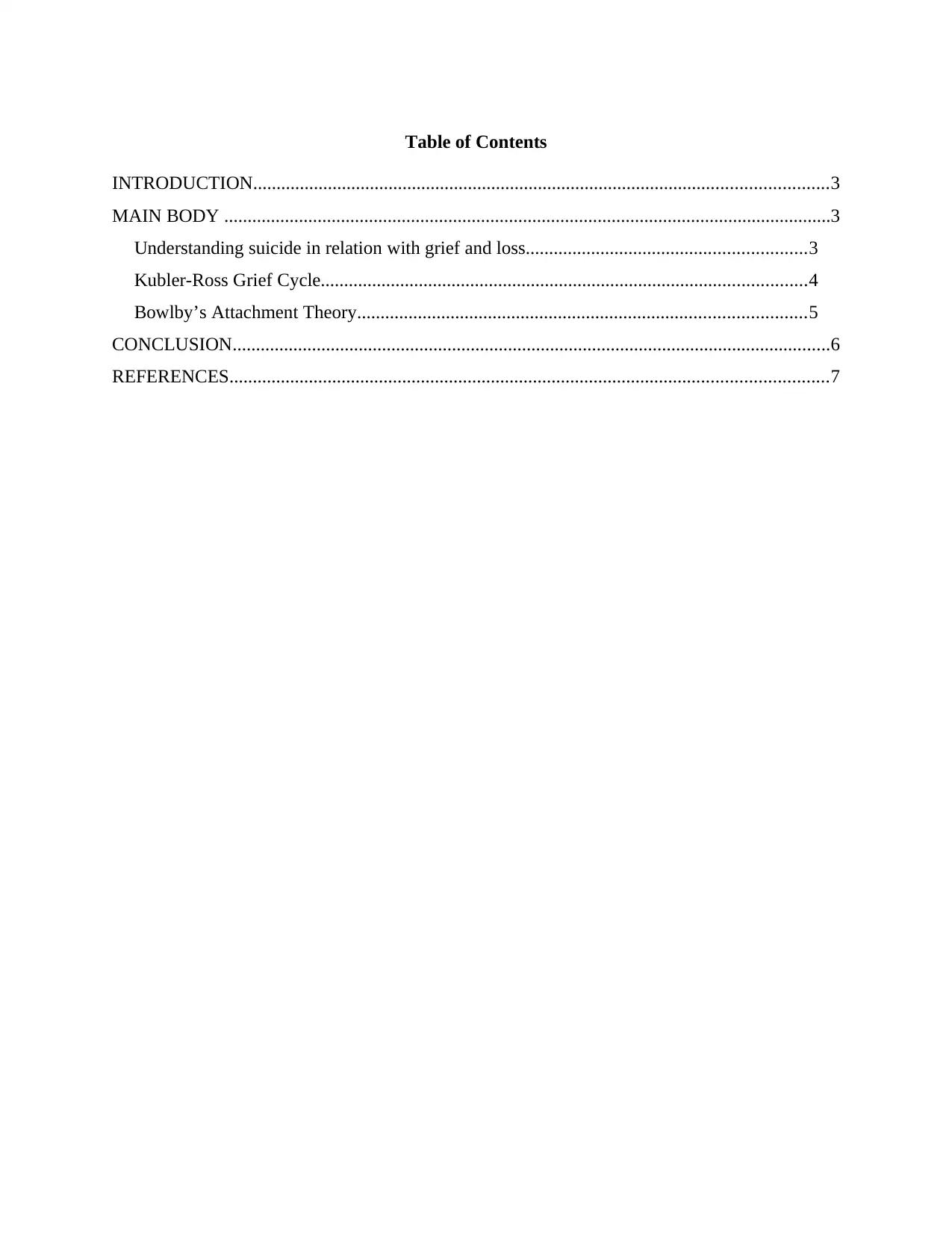
Table of Contents
INTRODUCTION...........................................................................................................................3
MAIN BODY ..................................................................................................................................3
Understanding suicide in relation with grief and loss............................................................3
Kubler-Ross Grief Cycle........................................................................................................4
Bowlby’s Attachment Theory................................................................................................5
CONCLUSION................................................................................................................................6
REFERENCES................................................................................................................................7
INTRODUCTION...........................................................................................................................3
MAIN BODY ..................................................................................................................................3
Understanding suicide in relation with grief and loss............................................................3
Kubler-Ross Grief Cycle........................................................................................................4
Bowlby’s Attachment Theory................................................................................................5
CONCLUSION................................................................................................................................6
REFERENCES................................................................................................................................7
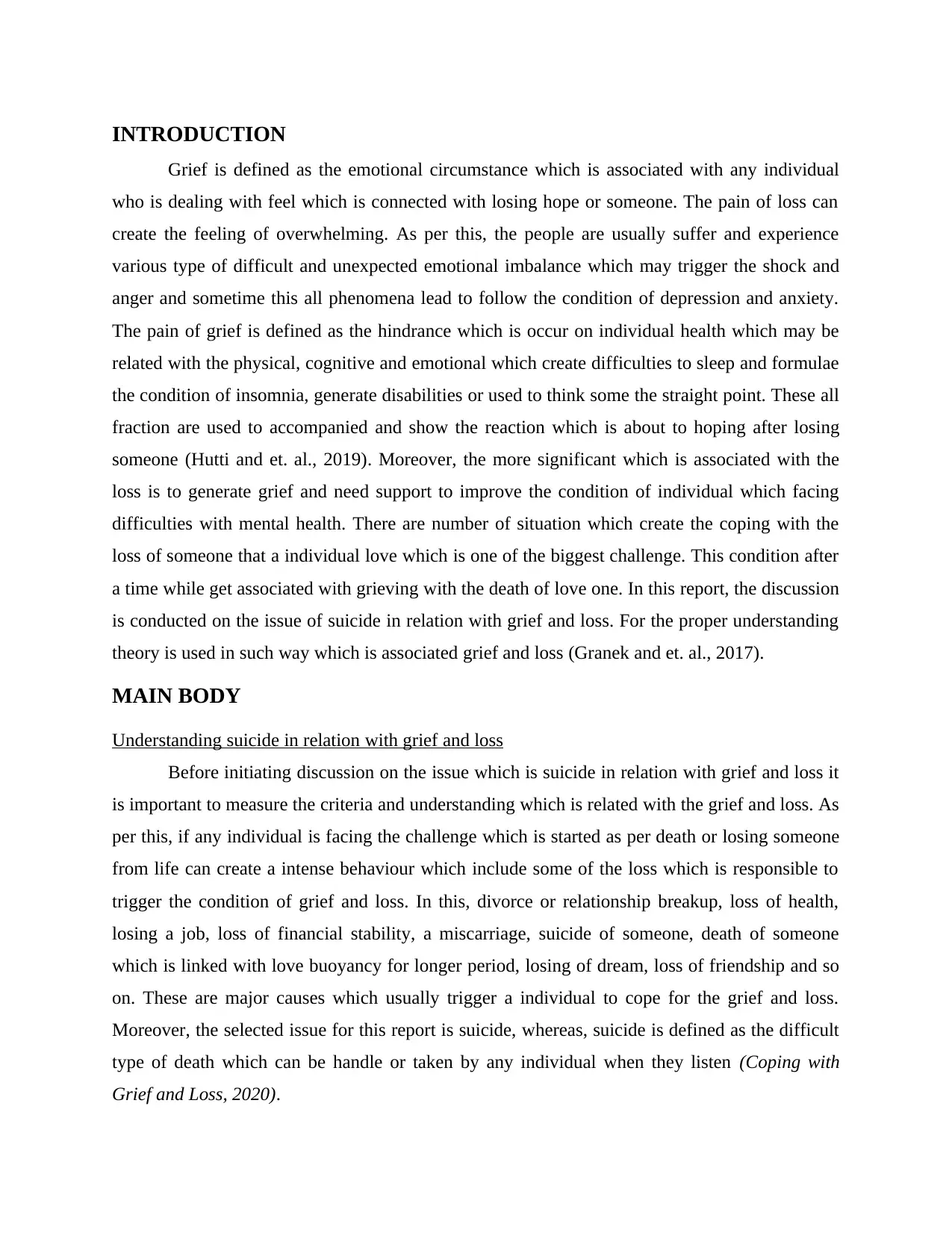
INTRODUCTION
Grief is defined as the emotional circumstance which is associated with any individual
who is dealing with feel which is connected with losing hope or someone. The pain of loss can
create the feeling of overwhelming. As per this, the people are usually suffer and experience
various type of difficult and unexpected emotional imbalance which may trigger the shock and
anger and sometime this all phenomena lead to follow the condition of depression and anxiety.
The pain of grief is defined as the hindrance which is occur on individual health which may be
related with the physical, cognitive and emotional which create difficulties to sleep and formulae
the condition of insomnia, generate disabilities or used to think some the straight point. These all
fraction are used to accompanied and show the reaction which is about to hoping after losing
someone (Hutti and et. al., 2019). Moreover, the more significant which is associated with the
loss is to generate grief and need support to improve the condition of individual which facing
difficulties with mental health. There are number of situation which create the coping with the
loss of someone that a individual love which is one of the biggest challenge. This condition after
a time while get associated with grieving with the death of love one. In this report, the discussion
is conducted on the issue of suicide in relation with grief and loss. For the proper understanding
theory is used in such way which is associated grief and loss (Granek and et. al., 2017).
MAIN BODY
Understanding suicide in relation with grief and loss
Before initiating discussion on the issue which is suicide in relation with grief and loss it
is important to measure the criteria and understanding which is related with the grief and loss. As
per this, if any individual is facing the challenge which is started as per death or losing someone
from life can create a intense behaviour which include some of the loss which is responsible to
trigger the condition of grief and loss. In this, divorce or relationship breakup, loss of health,
losing a job, loss of financial stability, a miscarriage, suicide of someone, death of someone
which is linked with love buoyancy for longer period, losing of dream, loss of friendship and so
on. These are major causes which usually trigger a individual to cope for the grief and loss.
Moreover, the selected issue for this report is suicide, whereas, suicide is defined as the difficult
type of death which can be handle or taken by any individual when they listen (Coping with
Grief and Loss, 2020).
Grief is defined as the emotional circumstance which is associated with any individual
who is dealing with feel which is connected with losing hope or someone. The pain of loss can
create the feeling of overwhelming. As per this, the people are usually suffer and experience
various type of difficult and unexpected emotional imbalance which may trigger the shock and
anger and sometime this all phenomena lead to follow the condition of depression and anxiety.
The pain of grief is defined as the hindrance which is occur on individual health which may be
related with the physical, cognitive and emotional which create difficulties to sleep and formulae
the condition of insomnia, generate disabilities or used to think some the straight point. These all
fraction are used to accompanied and show the reaction which is about to hoping after losing
someone (Hutti and et. al., 2019). Moreover, the more significant which is associated with the
loss is to generate grief and need support to improve the condition of individual which facing
difficulties with mental health. There are number of situation which create the coping with the
loss of someone that a individual love which is one of the biggest challenge. This condition after
a time while get associated with grieving with the death of love one. In this report, the discussion
is conducted on the issue of suicide in relation with grief and loss. For the proper understanding
theory is used in such way which is associated grief and loss (Granek and et. al., 2017).
MAIN BODY
Understanding suicide in relation with grief and loss
Before initiating discussion on the issue which is suicide in relation with grief and loss it
is important to measure the criteria and understanding which is related with the grief and loss. As
per this, if any individual is facing the challenge which is started as per death or losing someone
from life can create a intense behaviour which include some of the loss which is responsible to
trigger the condition of grief and loss. In this, divorce or relationship breakup, loss of health,
losing a job, loss of financial stability, a miscarriage, suicide of someone, death of someone
which is linked with love buoyancy for longer period, losing of dream, loss of friendship and so
on. These are major causes which usually trigger a individual to cope for the grief and loss.
Moreover, the selected issue for this report is suicide, whereas, suicide is defined as the difficult
type of death which can be handle or taken by any individual when they listen (Coping with
Grief and Loss, 2020).
⊘ This is a preview!⊘
Do you want full access?
Subscribe today to unlock all pages.

Trusted by 1+ million students worldwide
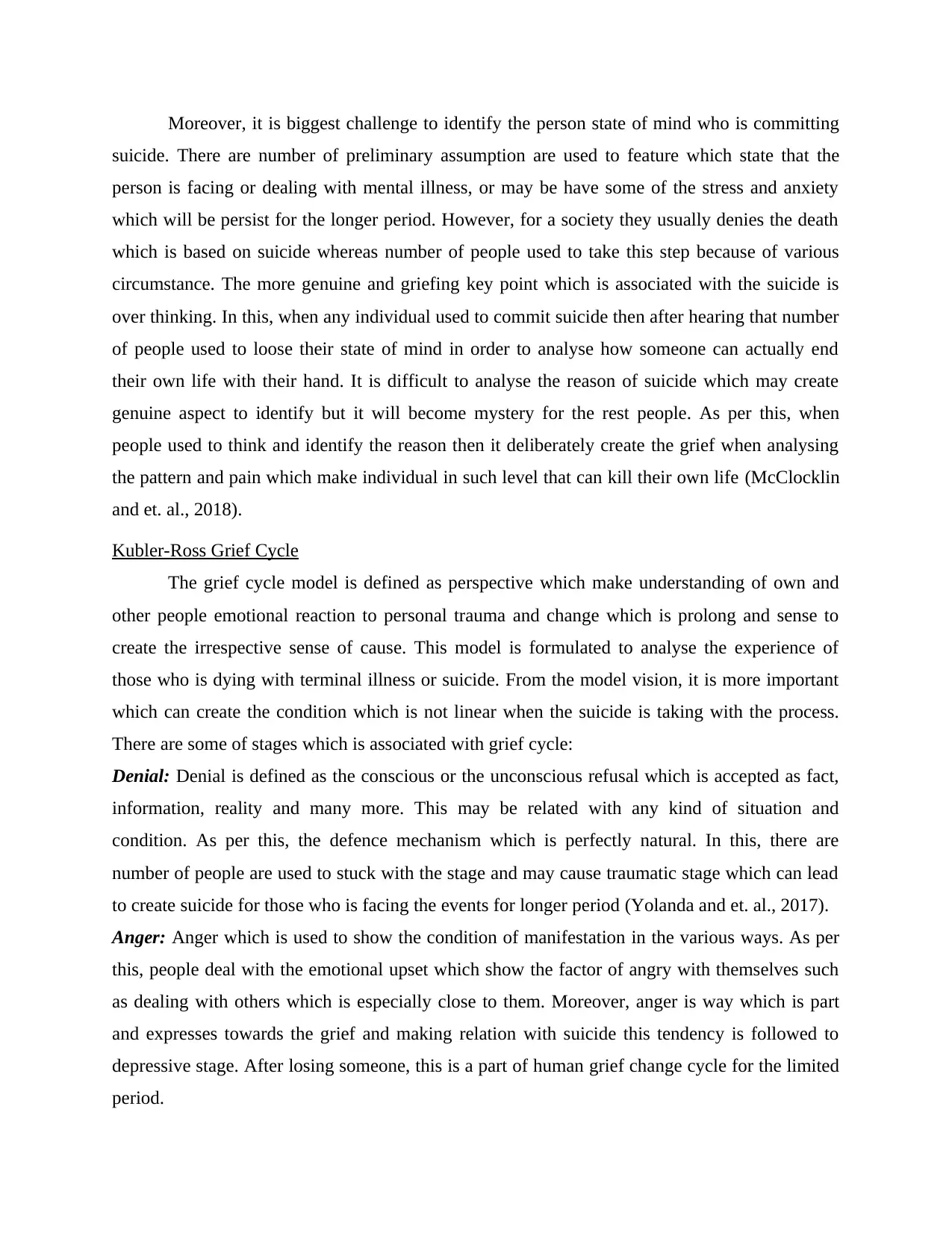
Moreover, it is biggest challenge to identify the person state of mind who is committing
suicide. There are number of preliminary assumption are used to feature which state that the
person is facing or dealing with mental illness, or may be have some of the stress and anxiety
which will be persist for the longer period. However, for a society they usually denies the death
which is based on suicide whereas number of people used to take this step because of various
circumstance. The more genuine and griefing key point which is associated with the suicide is
over thinking. In this, when any individual used to commit suicide then after hearing that number
of people used to loose their state of mind in order to analyse how someone can actually end
their own life with their hand. It is difficult to analyse the reason of suicide which may create
genuine aspect to identify but it will become mystery for the rest people. As per this, when
people used to think and identify the reason then it deliberately create the grief when analysing
the pattern and pain which make individual in such level that can kill their own life (McClocklin
and et. al., 2018).
Kubler-Ross Grief Cycle
The grief cycle model is defined as perspective which make understanding of own and
other people emotional reaction to personal trauma and change which is prolong and sense to
create the irrespective sense of cause. This model is formulated to analyse the experience of
those who is dying with terminal illness or suicide. From the model vision, it is more important
which can create the condition which is not linear when the suicide is taking with the process.
There are some of stages which is associated with grief cycle:
Denial: Denial is defined as the conscious or the unconscious refusal which is accepted as fact,
information, reality and many more. This may be related with any kind of situation and
condition. As per this, the defence mechanism which is perfectly natural. In this, there are
number of people are used to stuck with the stage and may cause traumatic stage which can lead
to create suicide for those who is facing the events for longer period (Yolanda and et. al., 2017).
Anger: Anger which is used to show the condition of manifestation in the various ways. As per
this, people deal with the emotional upset which show the factor of angry with themselves such
as dealing with others which is especially close to them. Moreover, anger is way which is part
and expresses towards the grief and making relation with suicide this tendency is followed to
depressive stage. After losing someone, this is a part of human grief change cycle for the limited
period.
suicide. There are number of preliminary assumption are used to feature which state that the
person is facing or dealing with mental illness, or may be have some of the stress and anxiety
which will be persist for the longer period. However, for a society they usually denies the death
which is based on suicide whereas number of people used to take this step because of various
circumstance. The more genuine and griefing key point which is associated with the suicide is
over thinking. In this, when any individual used to commit suicide then after hearing that number
of people used to loose their state of mind in order to analyse how someone can actually end
their own life with their hand. It is difficult to analyse the reason of suicide which may create
genuine aspect to identify but it will become mystery for the rest people. As per this, when
people used to think and identify the reason then it deliberately create the grief when analysing
the pattern and pain which make individual in such level that can kill their own life (McClocklin
and et. al., 2018).
Kubler-Ross Grief Cycle
The grief cycle model is defined as perspective which make understanding of own and
other people emotional reaction to personal trauma and change which is prolong and sense to
create the irrespective sense of cause. This model is formulated to analyse the experience of
those who is dying with terminal illness or suicide. From the model vision, it is more important
which can create the condition which is not linear when the suicide is taking with the process.
There are some of stages which is associated with grief cycle:
Denial: Denial is defined as the conscious or the unconscious refusal which is accepted as fact,
information, reality and many more. This may be related with any kind of situation and
condition. As per this, the defence mechanism which is perfectly natural. In this, there are
number of people are used to stuck with the stage and may cause traumatic stage which can lead
to create suicide for those who is facing the events for longer period (Yolanda and et. al., 2017).
Anger: Anger which is used to show the condition of manifestation in the various ways. As per
this, people deal with the emotional upset which show the factor of angry with themselves such
as dealing with others which is especially close to them. Moreover, anger is way which is part
and expresses towards the grief and making relation with suicide this tendency is followed to
depressive stage. After losing someone, this is a part of human grief change cycle for the limited
period.
Paraphrase This Document
Need a fresh take? Get an instant paraphrase of this document with our AI Paraphraser
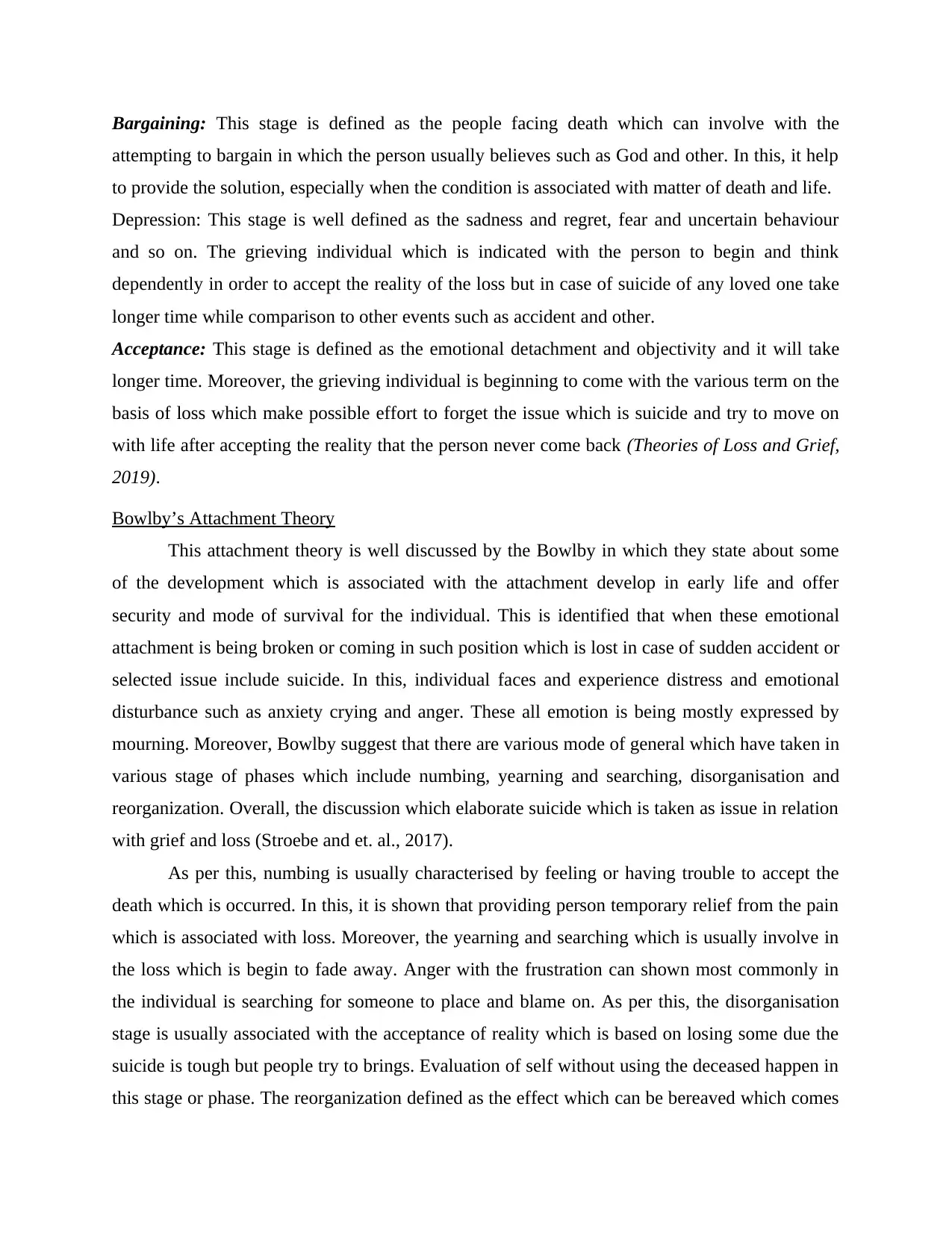
Bargaining: This stage is defined as the people facing death which can involve with the
attempting to bargain in which the person usually believes such as God and other. In this, it help
to provide the solution, especially when the condition is associated with matter of death and life.
Depression: This stage is well defined as the sadness and regret, fear and uncertain behaviour
and so on. The grieving individual which is indicated with the person to begin and think
dependently in order to accept the reality of the loss but in case of suicide of any loved one take
longer time while comparison to other events such as accident and other.
Acceptance: This stage is defined as the emotional detachment and objectivity and it will take
longer time. Moreover, the grieving individual is beginning to come with the various term on the
basis of loss which make possible effort to forget the issue which is suicide and try to move on
with life after accepting the reality that the person never come back (Theories of Loss and Grief,
2019).
Bowlby’s Attachment Theory
This attachment theory is well discussed by the Bowlby in which they state about some
of the development which is associated with the attachment develop in early life and offer
security and mode of survival for the individual. This is identified that when these emotional
attachment is being broken or coming in such position which is lost in case of sudden accident or
selected issue include suicide. In this, individual faces and experience distress and emotional
disturbance such as anxiety crying and anger. These all emotion is being mostly expressed by
mourning. Moreover, Bowlby suggest that there are various mode of general which have taken in
various stage of phases which include numbing, yearning and searching, disorganisation and
reorganization. Overall, the discussion which elaborate suicide which is taken as issue in relation
with grief and loss (Stroebe and et. al., 2017).
As per this, numbing is usually characterised by feeling or having trouble to accept the
death which is occurred. In this, it is shown that providing person temporary relief from the pain
which is associated with loss. Moreover, the yearning and searching which is usually involve in
the loss which is begin to fade away. Anger with the frustration can shown most commonly in
the individual is searching for someone to place and blame on. As per this, the disorganisation
stage is usually associated with the acceptance of reality which is based on losing some due the
suicide is tough but people try to brings. Evaluation of self without using the deceased happen in
this stage or phase. The reorganization defined as the effect which can be bereaved which comes
attempting to bargain in which the person usually believes such as God and other. In this, it help
to provide the solution, especially when the condition is associated with matter of death and life.
Depression: This stage is well defined as the sadness and regret, fear and uncertain behaviour
and so on. The grieving individual which is indicated with the person to begin and think
dependently in order to accept the reality of the loss but in case of suicide of any loved one take
longer time while comparison to other events such as accident and other.
Acceptance: This stage is defined as the emotional detachment and objectivity and it will take
longer time. Moreover, the grieving individual is beginning to come with the various term on the
basis of loss which make possible effort to forget the issue which is suicide and try to move on
with life after accepting the reality that the person never come back (Theories of Loss and Grief,
2019).
Bowlby’s Attachment Theory
This attachment theory is well discussed by the Bowlby in which they state about some
of the development which is associated with the attachment develop in early life and offer
security and mode of survival for the individual. This is identified that when these emotional
attachment is being broken or coming in such position which is lost in case of sudden accident or
selected issue include suicide. In this, individual faces and experience distress and emotional
disturbance such as anxiety crying and anger. These all emotion is being mostly expressed by
mourning. Moreover, Bowlby suggest that there are various mode of general which have taken in
various stage of phases which include numbing, yearning and searching, disorganisation and
reorganization. Overall, the discussion which elaborate suicide which is taken as issue in relation
with grief and loss (Stroebe and et. al., 2017).
As per this, numbing is usually characterised by feeling or having trouble to accept the
death which is occurred. In this, it is shown that providing person temporary relief from the pain
which is associated with loss. Moreover, the yearning and searching which is usually involve in
the loss which is begin to fade away. Anger with the frustration can shown most commonly in
the individual is searching for someone to place and blame on. As per this, the disorganisation
stage is usually associated with the acceptance of reality which is based on losing some due the
suicide is tough but people try to brings. Evaluation of self without using the deceased happen in
this stage or phase. The reorganization defined as the effect which can be bereaved which comes
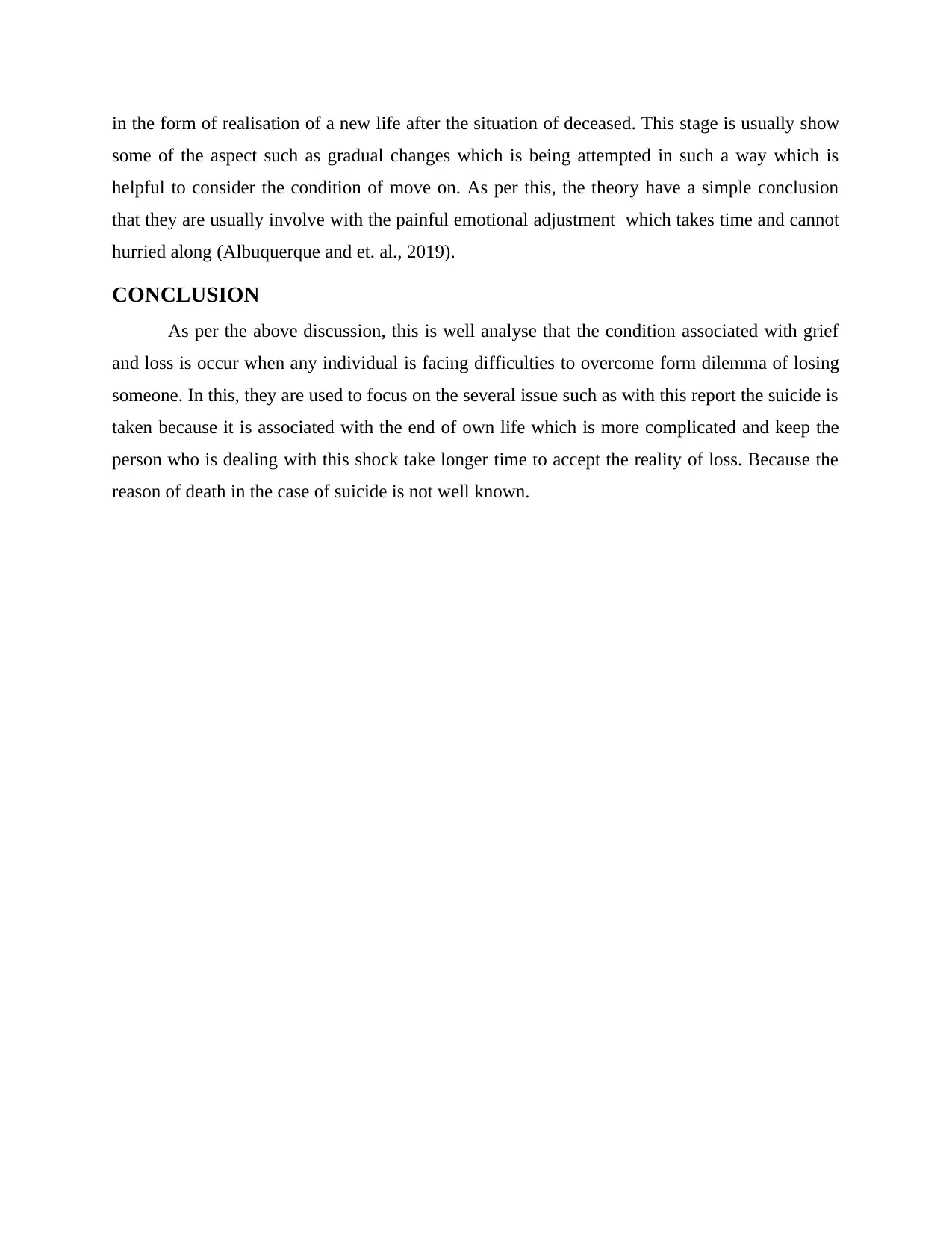
in the form of realisation of a new life after the situation of deceased. This stage is usually show
some of the aspect such as gradual changes which is being attempted in such a way which is
helpful to consider the condition of move on. As per this, the theory have a simple conclusion
that they are usually involve with the painful emotional adjustment which takes time and cannot
hurried along (Albuquerque and et. al., 2019).
CONCLUSION
As per the above discussion, this is well analyse that the condition associated with grief
and loss is occur when any individual is facing difficulties to overcome form dilemma of losing
someone. In this, they are used to focus on the several issue such as with this report the suicide is
taken because it is associated with the end of own life which is more complicated and keep the
person who is dealing with this shock take longer time to accept the reality of loss. Because the
reason of death in the case of suicide is not well known.
some of the aspect such as gradual changes which is being attempted in such a way which is
helpful to consider the condition of move on. As per this, the theory have a simple conclusion
that they are usually involve with the painful emotional adjustment which takes time and cannot
hurried along (Albuquerque and et. al., 2019).
CONCLUSION
As per the above discussion, this is well analyse that the condition associated with grief
and loss is occur when any individual is facing difficulties to overcome form dilemma of losing
someone. In this, they are used to focus on the several issue such as with this report the suicide is
taken because it is associated with the end of own life which is more complicated and keep the
person who is dealing with this shock take longer time to accept the reality of loss. Because the
reason of death in the case of suicide is not well known.
⊘ This is a preview!⊘
Do you want full access?
Subscribe today to unlock all pages.

Trusted by 1+ million students worldwide
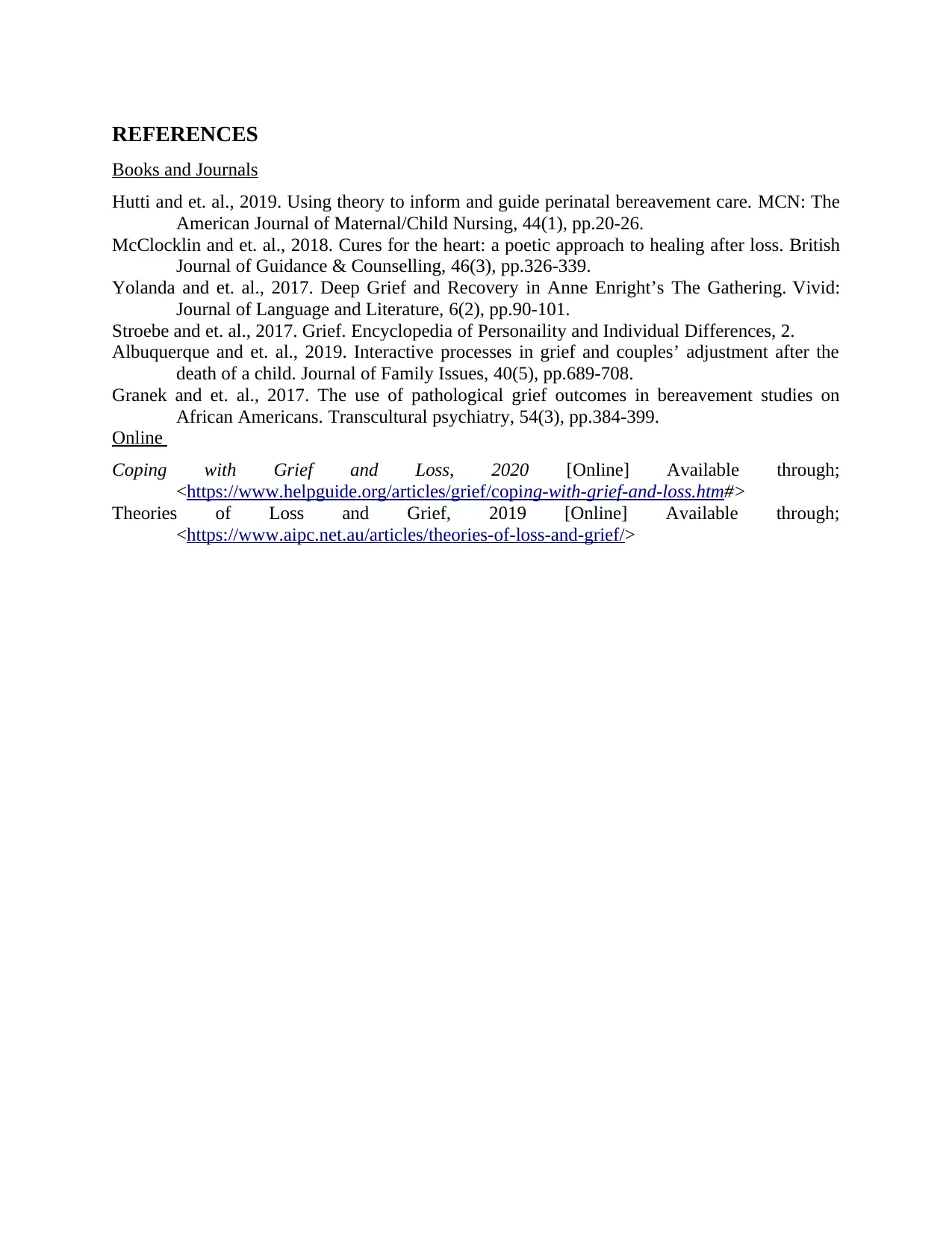
REFERENCES
Books and Journals
Hutti and et. al., 2019. Using theory to inform and guide perinatal bereavement care. MCN: The
American Journal of Maternal/Child Nursing, 44(1), pp.20-26.
McClocklin and et. al., 2018. Cures for the heart: a poetic approach to healing after loss. British
Journal of Guidance & Counselling, 46(3), pp.326-339.
Yolanda and et. al., 2017. Deep Grief and Recovery in Anne Enright’s The Gathering. Vivid:
Journal of Language and Literature, 6(2), pp.90-101.
Stroebe and et. al., 2017. Grief. Encyclopedia of Personaility and Individual Differences, 2.
Albuquerque and et. al., 2019. Interactive processes in grief and couples’ adjustment after the
death of a child. Journal of Family Issues, 40(5), pp.689-708.
Granek and et. al., 2017. The use of pathological grief outcomes in bereavement studies on
African Americans. Transcultural psychiatry, 54(3), pp.384-399.
Online
Coping with Grief and Loss, 2020 [Online] Available through;
<https://www.helpguide.org/articles/grief/coping-with-grief-and-loss.htm#>
Theories of Loss and Grief, 2019 [Online] Available through;
<https://www.aipc.net.au/articles/theories-of-loss-and-grief/>
Books and Journals
Hutti and et. al., 2019. Using theory to inform and guide perinatal bereavement care. MCN: The
American Journal of Maternal/Child Nursing, 44(1), pp.20-26.
McClocklin and et. al., 2018. Cures for the heart: a poetic approach to healing after loss. British
Journal of Guidance & Counselling, 46(3), pp.326-339.
Yolanda and et. al., 2017. Deep Grief and Recovery in Anne Enright’s The Gathering. Vivid:
Journal of Language and Literature, 6(2), pp.90-101.
Stroebe and et. al., 2017. Grief. Encyclopedia of Personaility and Individual Differences, 2.
Albuquerque and et. al., 2019. Interactive processes in grief and couples’ adjustment after the
death of a child. Journal of Family Issues, 40(5), pp.689-708.
Granek and et. al., 2017. The use of pathological grief outcomes in bereavement studies on
African Americans. Transcultural psychiatry, 54(3), pp.384-399.
Online
Coping with Grief and Loss, 2020 [Online] Available through;
<https://www.helpguide.org/articles/grief/coping-with-grief-and-loss.htm#>
Theories of Loss and Grief, 2019 [Online] Available through;
<https://www.aipc.net.au/articles/theories-of-loss-and-grief/>
1 out of 7
Related Documents
Your All-in-One AI-Powered Toolkit for Academic Success.
+13062052269
info@desklib.com
Available 24*7 on WhatsApp / Email
![[object Object]](/_next/static/media/star-bottom.7253800d.svg)
Unlock your academic potential
Copyright © 2020–2025 A2Z Services. All Rights Reserved. Developed and managed by ZUCOL.





